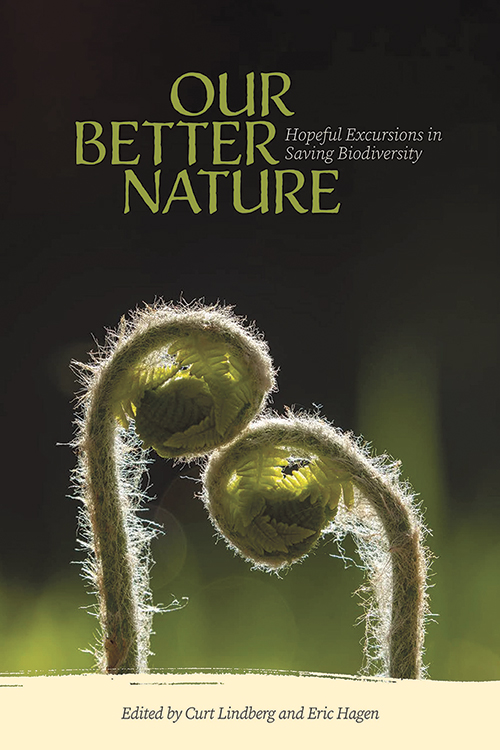
Our Better Nature: Hopeful Excursions in Saving Biodiversity
Reviewed by Ruah Swennerfelt
April 1, 2023
Edited by Curt Lindberg and Eric Hagen. Vermont Alliance for Half-Earth, Northeast Wilderness Trust, Vermont Natural Resources Council, and the Lintilhac Foundation, 2022. 240 pages. $34.99/paperback; $9.99/eBook.
In our troubled times, it’s so refreshing and inspiring to hear hopeful stories of the amazing work done by individuals and groups who care about the health and welfare of people and all creation. That’s just what you’ll find when you read Our Better Nature. I had the good fortune of meeting Eric Hagen last fall when he gave me a copy of his new book. Then, this past January (after I had written this review), I attended a lively online discussion series about the book hosted by some groups local to my community, with Zoom visits from Hagen and some of the authors on the last evening.
A major inspiration for the book came from the life and work of Edward O. Wilson, a pioneering biologist and author. In fact, the book was created by the Vermont Alliance for Half-Earth, which is pursuing Wilson’s vision of halting the decline of nature and extinction of species by dedicating half of Earth’s surface to nature.
Author Tom Butler asks in one of the chapters: “If the world humanity is making is based largely on the tales we tell ourselves, do we have the right ones?” What could the stories be that would help us shape a saner world? And although the stories in the book come from Vermont, there’s plenty to learn and adapt to wherever you live. One is about Sandra Fary, a middle-school science teacher in Vermont who includes an ornithology unit in her curriculum. Her students spend six weeks learning about the lives, behavior, and songs of birds. During that unit the students go on a three-day ornithological field trip. They come back filled with awe and new understanding of the importance of nature, and they’re inspired to protect what they now know is important.
George Schenk, a farmer and entrepreneur, began to look at his land with new eyes when he learned that fallen trees can be important habitats for all sorts of creatures. After he had stopped automatically clearing them, he found animal tracks under a fallen tree: proof of what he had learned. He then asked himself what he could do “to be responsible to the agricultural interests of the farm and its food production values, but also responsible to wildlife.” He has since created structures for wildlife to use, such as leaving brush piles and using extra-tall fence posts. The birds, insects, and various animals make use of the structures.
Through the book, we learn about the importance of creating spaces for human contemplation and animal welfare. We learn how healing nature can be. We learn how, in the language of the Abenaki (an Indigenous people of Vermont), things in nature are spoken of as imbued with life. Andrea Brett, an Abenaki native Vermonter, explains: “Plants and animals, and even water, the wind, and stones, are all spoken about with a sense of animacy and agency.” If this is not our language, how can we still learn the language of the land? We are told that we need to listen to what the water, the plants, and the animals are saying.
The final section of the book is about how we can take action. It includes lots of practical suggestions and resources. Then we are treated to an insightful afterword by Doug Tallamy, author of three important books for home gardeners: Bringing Nature Home, Nature’s Best Hope, and The Nature of Oaks. He ends with these words: “We can ourselves join the legion of species being obliterated from the Earth—or we can change our adversarial relationship with nature to a collaborative one.”
This is a book for everyone! The hope and inspiration it gives will help us sleep better; look forward to each day; and, hopefully, take some action.
Ruah Swennerfelt is a member of Middlebury (Vt.) Meeting, where she serves on the Earthcare Committee. She is also on New England Yearly Meeting’s Earth Quaker Justice Team. Along with her husband, she homesteads on the unceded lands of the Abenaki.
1 thought on “Our Better Nature: Hopeful Excursions in Saving Biodiversity”
Leave a Reply
Comments on Friendsjournal.org may be used in the Forum of the print magazine and may be edited for length and clarity.



We live and garden on unceded Abenaki land in coastal Maine, living as gently as we know how.